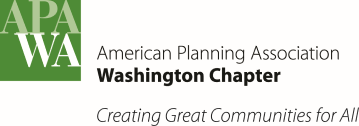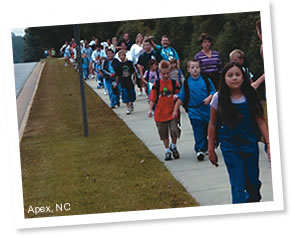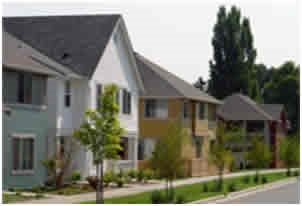- About Us
- Events & Training
- Professional Development
- Sponsorship
- Get Involved
- Resources
Sustainable Washington3.10 Public HealthAs described in 3.1, Climate Impacts and Hazards, as planners we must ensure that our communities are prepared to adapt to the impacts associated with climate change – this is as true for on-going public health as it is for more specific health emergencies and disasters. Modern city planning in the United States has its roots in public health. During the early 1900s, public health concerns about the sanitary conditions of tenement housing and factories became the basis for the development of zoning. Euclidean zoning offered the tools to separate potentially unhealthy uses from people. Once cities were able to control the spread of infectious diseases, public health and planning gradually went their separate ways – until the 1990s. Now, public health issues are again becoming intertwined with urban planning, but with a focus on chronic, rather than infectious, disease. In the last half of the 20th century, the combination of suburban zoning and cheap transportation formed a powerful alliance encouraging low-density development and sprawl, resulting in an ever-increasing dependence on private vehicles for mobility. Obesity, heart disease, asthma, social isolation, and some mental illnesses have all been linked to this development pattern, which has been fueled by relatively inexpensive energy. Inexpensive energy has also facilitated a food industry that is heavily dependent on carbon fuels (for transport, machinery, fertilizers) and has altered our diets. Public health is also related to social equity. Access to a healthy lifestyle (mobility options such as trails and sidewalks, local/ organic food, clean air and water) and exposure to health stressors (such as crime, noise, and noxious land uses) have been correlated by studies to income and race. Climate change brings another level of complexity to planning for healthy communities. As much as planning for low-carbon dependence will help moderate climate change, it can also have far-reaching impacts on the price and access to food, community travel choices, availability of potable water, clean air, quality of food, and the incidence of new diseases. Climate change will continue to create new scenarios that will affect public health in a number of ways, such as:
Mitigating and adapting to climate change prompts planners to think outside the box about public health and health delivery and how this relates to planning for our communities. ActionsThe following list of actions is separated into three categories: Getting Started, Making a Commitment, and Expanding the Commitment. This categorical approach allows jurisdictions to implement measures that are appropriate to their community’s current level of involvement in climate change and sustainability issues and in consideration of locally adopted plans, codes, regulations, policies and goals. Getting Started3.10.1 Encourage healthy lifestyles through measures proposed to mitigate GHGs.Work with local health providers to publicize information letting people know that measures proposed to mitigate GHGs (e.g. reducing reliance on automobile travel, the availability of more local food) can also encourage a healthy lifestyle. Somerville, MA Support a reduction in driving by using a health promotion approach in the design of the built environment – e.g., design for walkability and bikability rather than for short trips to be taken by car. Work closely with organizations that advocate and provide resources for non-motorized transportation to inform planning strategies that deal with these topics. While it may be difficult, especially for smaller jurisdictions, to find the financing to improve things such as bicycle infrastructure, advocacy organizations can provide key support and guidance in the planning stage. (Local and State Action) 3.10.2 Encourage healthy lifestyles for youth. Promote Safe Routes to School.Encourage children to travel to school by bicycling and walking, thus, increasing health benefits for youth and reducing emissions and congestion from automobile use. (Local Action) 3.10.3 Plan for healthy urban development.In areas where more compact communities are proposed, develop local standards that enable project designers to incorporate features conducive to maintaining physical and mental health – clean water, clean air, mobility options, community building, opportunities for socializing, etc. – into project design. (Local and State Action) See the High Point Neighborhood case study. 3.10.4 Plan for healthy rural development.Recognize that climate change may impact lifestyles (and thus public health) in rural and remote communities through changes to resource-based economies and tourism, the availability/affordability of transportation, and the availability of certain foods. Work to sustain healthy, diverse rural communities and recognize that adaptation to the changing climate may require very different strategies for different communities. (Local and State Action) 3.10.5 Partner with public health.
Assist public health officials in identifying and mapping areas of specific health risks and preparing an assessment of community health status. Work with public health officials to ensure that health alerts such as air quality or disease alerts are well publicized and reach all members of the community, including those of limited English-proficiency. Making a Commitment3.10.6 Reduce health impacts from climate change.Identify disproportionate health impacts from climate change – especially for vulnerable populations such as minority, low-income, elderly, very young, and disabled populations. Work with local health agencies to develop strategies to address these impacts. Be aware of the possibility of new infectious and/or vector-borne diseases that may emerge in your community. (Local Action) 3.10.7 Minimize heat impacts through design.In project design, recognize and avoid the creation of “heat islands”; develop strategies for cooling in both urban and rural environments. Incorporate new thinking on “Engineering for Cooler Climates,” including cool roofs, urban forestry, natural or radiant heating and cooling, etc. Increase the number of trees on public and private lands. Install street trees within downtown areas and neighborhoods to provide cleaner air, shade and cooling during heat waves. Encourage retention of trees on private property, use of pervious surfaces in parking areas, and reduction in maximum lot coverage. (Local Action) 3.10.8 Conduct a Health Impact AssessmentRecognize that carbon-dependent community design has contributed to chronic diseases, increased health care costs, and mortality in children (as well as adults). Involve public health officials and use tools such as health impact assessments to improve the health of your community’s lifestyle and living during comprehensive planning and master planning efforts. (Local Action) 3.10.9 Remove barriers to the delivery of health services.Ensure that local land use regulations do not hinder delivery of new or expanded health services. Location and access to clinics or health care centers could be considered necessary infrastructure and addressed deliberately during comprehensive planning (by public, private, or non-profit agencies). Backup electricity and communication to these services need to be planned for to accommodate the increased occurrences of natural disasters. (Local Action) 3.10.10 Include health issues in disaster planning.Expand disaster planning to anticipate more extreme weather events and potential health issues related to cleanup activities. Sanitary conditions within temporary relocation camps, the exposure to toxins by emergency care providers, and availability of clean water and heat/ cooling during disasters need to be incorporated into emergency management planning and infrastructure. (Local Action) Expanding the Commitment3.10.11 Apply an ecosystems approach to urban environments.Seek to develop sustainable urban ecosystems that provide for urban services, mobility and economic activity while integrating open space, recreation, habitat, and aesthetic enjoyment. (Local and Regional Action) 3.10.12 Integrate health issues into overall planning.Work with public health officials to identify potential GHG mitigation and public health adaptation measures that can be incorporated into land use planning and design activities. Work with public health officials to identify unintended consequences of mitigation measures designed to reduce GHG emissions. For example, if fuel prices increase, the types and availability of certain foods may change, affecting the local diet, especially in rural and more remote communities. (Local and State Action) 3.10.13 Plan for community health.Work with public health officials to develop or reward plans that show measurable improvements in a community’s health indicators. Create regional partnerships of fresh produce providers and health officials to examine ways to provide access to fresh organic produce to all sectors of society equally. (Local and State Action) See King County’s Steps to Health Program.
|

 Somerville, MA, a Boston suburb, instituted the “Shape Up Somerville” to reduce childhood obesity. Among other measures was the creation of “walking school buses” and “bicycle trains.” These activities, in which a few parents walk or bike to school and pick up school children along the way, provide a neighborhood-strengthening way to get healthy. More information can be found at
Somerville, MA, a Boston suburb, instituted the “Shape Up Somerville” to reduce childhood obesity. Among other measures was the creation of “walking school buses” and “bicycle trains.” These activities, in which a few parents walk or bike to school and pick up school children along the way, provide a neighborhood-strengthening way to get healthy. More information can be found at 
